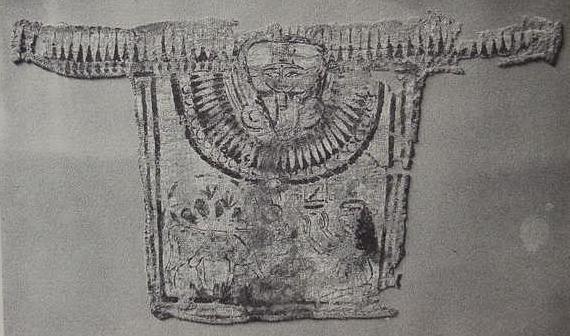Textile votives dedicated to Hathor consist of shirts and cloths. Some cloths' top row of fringe are looped with a cord passing through the loops (perhaps for hanging ?). Many have paintings or embroidery work showing supplicants adoring Hathor in two forms, as a human goddess with cow horns and sun disc on her head or in bovine form, sometimes accompanied by a calf. In Egyptian myth Hathor was a sky-cow-goddess who gave birth to the sun as a calf that rode the solar bark or boat of the Sun-god Re. In some myths the deceased pharaoh is portrayed declaring that he is the GOLDEN CALF, born of the sky and declares his right to ride the solar barge (cf. The Pyramid Texts of the Old Kingdom).
I understand that the "weavings" made by women for the Asherah in the temple of Solomon may be recalling votive cloths for Hathor who in Late Bronze Age times was assimilated to many different forms of the Canaanite goddess of sex and love.
Below, a painted shirt with the head of Hathor and a scene of her in bovine form adored by a female supplicant from Deir el-Bahri, Egypt (Plate 14 figure B. Geraldine Pinch. Votive Offerings to Hathor. Oxford. Griffith Institute. Ashmolean Museum 1993. ISBN 0-900416-55-6)
Below, a cloth with fringe. The top fringe looped with a cord passing through the loops. Hathor is on the solar bark which bears a draped shrine. Behind her are papyrus reeds in blossom. Below her chin is Pharaoh, her calf, who was honored as the Sun in human form under Amenhotep III and succeeding pharaohs. (cf. Plate 25. figure B. Pinch. 1993)
Below, a drawing of a votive cloth from Deir el-Bahri with looped fringe across the top. Hathor in bovine form stands on a pedestal. The markings on her body represent the midnight sky and its stars, she being a form of Nut, another cow-sky-goddess. In the morning the night sky gave birth to the sun as a Golden Calf. Supplicants present flowers to the goddess. Hathor was associated with lotus and papyrus flowers because in a papyrus marsh she shielded the infant Horus, another form of the sun-god, from his enemies(cf. Figure 11. A. Pinch. 1993)
